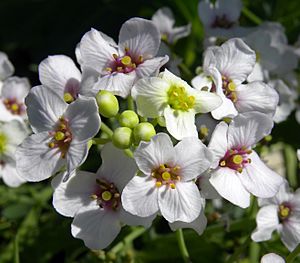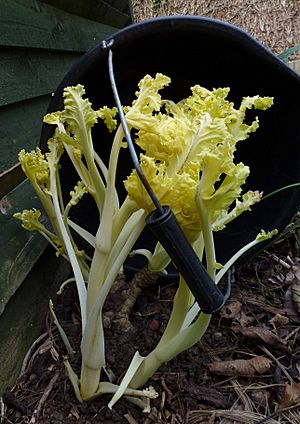Sea kale facts for kids
Quick facts for kids Sea kale |
|
|---|---|
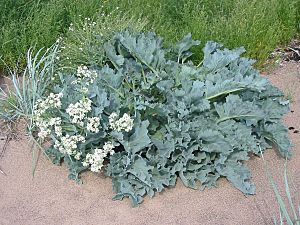 |
|
| Growing in Estonia | |
| Scientific classification | |
| Genus: |
Crambe
|
| Species: |
maritima
|
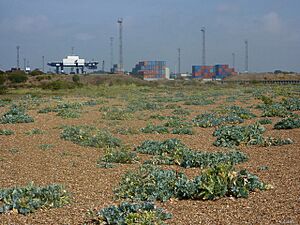
Sea kale (its scientific name is Crambe maritima) is a type of flowering plant. It's a special kind of plant called a halophyte, which means it can grow in salty places. You can find sea kale growing wild along the coasts of Europe, from the Atlantic Ocean all the way to the Black Sea.
This plant is related to the cabbage. People first started growing it as a vegetable in Britain around the 1700s. The blanched (whitened) stems are eaten as a vegetable. It became quite popular in Britain during the Victorian times, in the mid-1800s.
Contents
What Does Sea Kale Look Like?
Sea kale can grow up to about 75 centimeters (30 inches) tall and 60 centimeters (24 inches) wide. It grows in a mound shape and spreads out. It's a perennial plant, which means it lives for more than two years.
It has large, thick leaves that are a blue-green color. It also has many white flowers. After the flowers, it forms round pods, and each pod holds just one seed.
Where Does Sea Kale Grow?
Sea kale is a plant that is native to Europe. It grows in two main areas along the coast. You won't find it in North Africa or the Middle East.
It grows along the Black Sea coasts in countries like Bulgaria, Romania, Turkey, and Ukraine (including Crimea). However, it's not found in most of the Mediterranean Sea. You'll see it again from northern France and Ireland up to the Baltic Sea.
In some parts of Europe, like Portugal, Greece, Italy, and Spain, a similar plant called Crambe hispanica grows instead. Sea kale is very rare in Northern Ireland and some parts of Ireland. In England, it's mostly found on the southern coast, but also in East Anglia and Cumbria. In Wales, it grows on northern beaches, and in Scotland, it's in the far southwest. You can also find it along the coast of Norway, especially in the Færder National Park.
How Sea Kale Lives in Nature
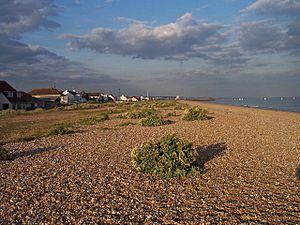
As a halophyte, sea kale loves salty environments. It usually grows above the high tide line on beaches that have pebbles or rocks mixed with sand. In Britain, it often grows on shingle beaches (beaches made of small stones). Here, it can be found with other plants like yellow horned poppy and curled dock.
Sea kale is a very important plant in the plant communities found on shingle beaches along the southern Baltic coasts. It grows with other plants like Leymus arenarius and Euphorbia palustris. When sea kale grows in clumps, it can trap sand blown by the wind. This can even help new sand dunes to form!
Growing and Eating Sea Kale
People have been harvesting sea kale for a long time. Records from the 1700s show that people in England would dig up the young shoots in early spring to eat as a vegetable.
In 1799, a man named William Curtis shared his ideas on how to grow sea kale as a crop. He suggested a method called "blanching." This means growing the plant in the dark to make the shoots pale and tender. Gardeners would cover the plant's root with a ceramic pot or even a pile of soil, sand, or pebbles. They might even add fresh manure on top to create heat, which would make the plant grow faster, even in winter.
Famous people like Thomas Jefferson grew sea kale in the early 1800s. It was even served at the Royal Pavilion in Brighton, a favorite place of Prince Regent George IV of the United Kingdom. By the Victorian era, sea kale was very common in Britain. Cookbooks like Mrs Beeton's Book of Household Management called it a type of asparagus. However, it was quite expensive back then.
Wild sea kale plants in Britain were harvested so much that their numbers dropped. Because of this, collecting them from the wild was banned in the early 1900s. Sea kale became less popular for a while. But in the early 2000s, British chefs started using it again, making it fashionable once more. Today, some farmers in Britain grow it commercially.
People have described blanched sea kale as a delicious food. When boiled and served with melted butter, it tastes a bit like asparagus, but also has hints of cabbage. Some people even thought it tasted better than asparagus!
Sea Kale as a Garden Plant
Sea kale is not just for eating; it's also a beautiful plant for gardens. Because of its attractive look, Crambe maritima has won an important award called the Royal Horticultural Society's Award of Garden Merit.
|
See also
 In Spanish: Col marina para niños
In Spanish: Col marina para niños


